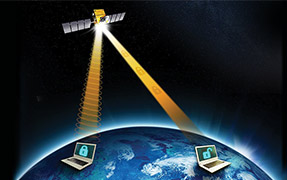#FacesofPhotonics: Stargazer Stacey Sueoka
Let's go back to 2005: Stacey Sueoka, an undergraduate at the time, spent the summer at the US Naval Research Lab (NRL) conducting research alongside her advisor Dr. James Butler. "It was my first exposure to a real optics lab," she says. "High-powered lasers, fancy optical systems, photonic crystal fibers — there were so many fun toys."
After a second stint at NRL in the summer of 2006, her interest in optics was officially piqued. She applied for the Akamai Internship Program the following summer and spent eight weeks with Textron Systems in Maui, assisting with the radiometric calibration of a laser receiver system for the Air Force Advanced Electro-Optical System — a 3.67-meter telescope.
The Akamai program, led by the Institute for Scientist and Engineer Educators (ISEE) at UC Santa Cruz, offers college students from Hawaii the opportunity to gain summer work-experience at an observatory, company, or technical facility in Hawaii. "I left the program even more fascinated by optics," she says. "It reinforced my interest in pursuing a graduate degree in optical sciences."
The internship also opened Stacey's eyes to the vast range of the science and technology industry in Hawaii. "It gave me a better understanding of what kind of job opportunities and work environment were available in my home state."
She went on to receive her PhD from the University of Arizona's College of Optical Sciences, and now works as an optical systems engineer at the National Solar Observatory (NSO). Her focus is the National Science Foundation's (NSF) Daniel K. Inouye Solar Telescope (DKIST) in Maui. Not only is she assisting with the construction of the telescope, but she is also an active advocate for diversity and inclusion programs in observatory operations. Her team's paper on this topic was a combined effort of the Gemini Observatory, National Optical Astronomy Observatory, and NSO, and part of the SPIE Astronomical Telescopes + Instrumentation Proceedings in 2018.
Enjoy the Faces of Photonics interview with Stacey!

LOOK AT US NOW: Sueoka and Akamai internship program alums Brialyn Onodera, Chriselle Galapon, and Mary Liang now work together on the DKIST telescope.
1. Describe a memorable moment from an SPIE event or conference.
My most memorable moment from an SPIE conference was at the 2016 Astronomical Telescopes + Instrumentation conference in Edinburgh. There was a Women in Optics luncheon talk by Dame Jocelyn Bell Burnell where she explained her career trajectory in astrophysics, and the obstacles she had to overcome. It was a real revelation for me, as I have not experienced similar challenges in my career path.
It is thanks to women like her that our generation is so fortunate. It made me realize that there is much more we can do to make the astrophysics community — and the STEM community in general — stronger and better for future women in science.
2. Explain your current research/what you do at your job. How does your work impact society?
I work as an optical systems engineer for the DKIST. It is currently in construction at the summit of Haleakala on the island of Maui. My job as an optical engineer focuses on designing, testing, and integrating the optics and optical systems for the telescope. Another large part of my work is in polarization systems engineering. I work closely with the polarimetry and instrument scientists to ensure DKIST can achieve all of its scientific goals to study the sun using polarimetry.
DKIST will be the world's most powerful solar observatory, and it will allow us to answer fundamental questions in solar physics. Not only that, but it will help us understand the role of the magnetic fields on the solar dynamo and solar activity. Modern human life is very dependent on communications and satellite systems, which benefit from a more concrete understanding of solar activity on space weather.

OPTICS ALIGN: Sueoka and the DKIST team install a new optical system into the telescope.
3. Share the story of your favorite outreach or volunteer experience.
A huge benefit of being part of a large telescope project such as DKIST is being involved with STEM programs such as the Akamai Workforce Initiative, the program that provided me with an internship in 2007.
Since starting my job with NSO four years ago, I have been involved at different levels of the Akamai program: teaching optics inquiry-style activities in the preparatory course, co-mentoring an intern, and teaching communications and presentation skills for the interns' end-of-the-year symposium. I am really excited to be a part of this program because it provides networking, exposure, and other professional opportunities for these students. Perhaps it will help them, as it did me, return to their home state with a job in the future!
4. What is your advice to others in the STEM community?
For those of you interested in doing more outreach and volunteer work, there are plenty of opportunities! I think optics is a particularly special field when it comes to engaging a broader audience. There are hundreds of "blow-your-mind" demos and so many real-world applications — even understanding the simplest natural phenomena can teach fundamental concepts in optics. By sharing our passion for what we do, those in the optics community can excite the younger generation and inspire them to be future optical engineers and scientists!
For those of you who are already involved in outreach work and want to step it up a notch, I would recommend looking into STEM-educational workshops. One thing I have learned from attending ISEE's Professional Development Program is there is always room for improvement in teaching STEM.
| Enjoy this article? Get similar news in your inbox |
|



